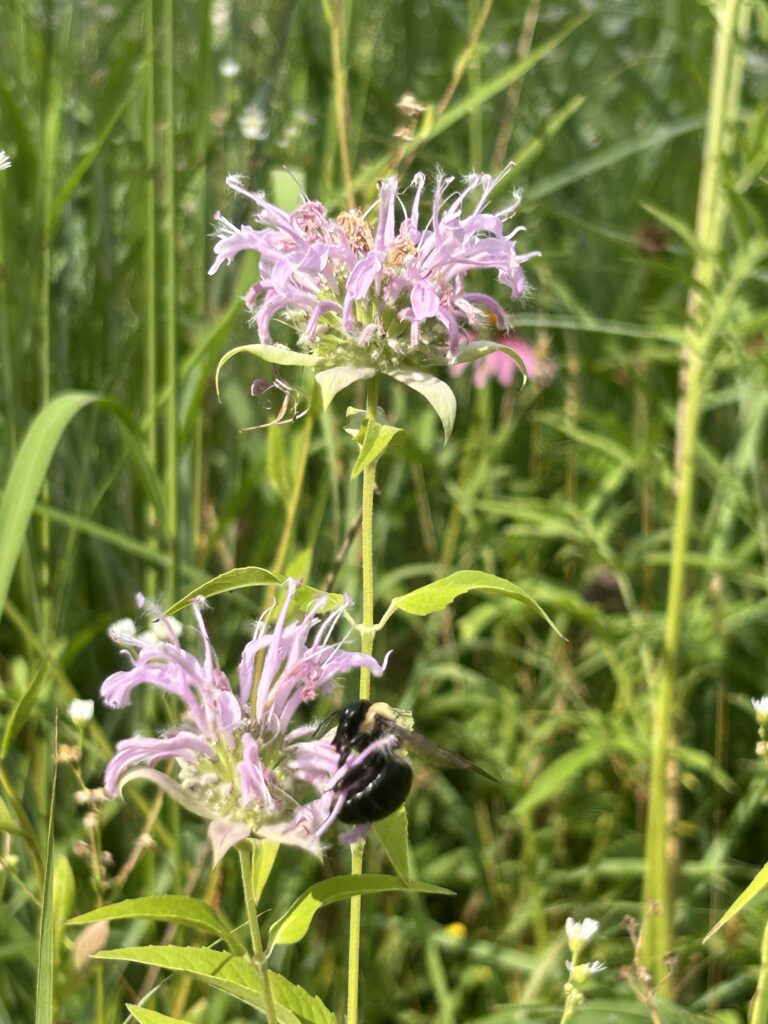If you want a garden, farm, or native meadow that thrives without constant chemical input, start by attracting the right insects.
Pollinators like bees and butterflies are essential for seed and crop production, while natural pest predators such as parasitic wasps and hoverflies keep destructive bugs in check. The best way to bring these “good bugs” into your landscape is to plant native flowers that support them through every stage of their life cycle.
In this blog, you’ll find:
- A clear explanation of what makes an insect “beneficial”
- Eight native plants that attract beneficial insects
- Practical details on how to plant and maintain each species
Let’s start with the basics.
What Is a Beneficial Insect?
A beneficial insect is any insect that provides a service to the ecosystem or to people, most often by pollinating plants or by preying on pests. Native bees, butterflies, parasitic wasps, hoverflies, and lady beetles are all considered beneficial because they support plant reproduction or help control insects that damage crops and ornamentals.
By contrast, a “non-beneficial” insect isn’t necessarily harmful, but may simply have no clear impact. True pests, like aphids or Japanese beetles, damage plants and reproduce quickly without contributing to pollination or pest control. Left unchecked, they can throw a garden’s ecosystem out of balance.
The goal of attracting beneficial insects is to strengthen that balance naturally. When you create habitat for pollinators and pest predators, you build a healthier, more self-sustaining landscape.
The eight native flowers below are among the most effective plants for attracting beneficial insects in the Northeastern U.S.
8 Native Plants that Attract Beneficial Insects
The eight flowers listed below are all native to the Northeastern United States and available through Ernst Conservation Seeds. For each plant, you’ll find a concise profile covering what it looks like, what conditions it thrives in, how and when to plant it, and which beneficial insects it supports.
1. Milkweed (Asclepias spp.)
Milkweed is best known for its vital role in supporting monarch butterflies, but its benefits extend to a wide range of pollinators and predatory insects. With upright stems and clusters of pink or orange flowers, milkweed adds structure and fragrance to any planting.
Growing conditions:
Full sun; well-drained to moist soil, depending on species. A. tuberosa (Butterfly Milkweed) prefers dry, sandy soils, while A. incarnata (Swamp Milkweed) thrives in wetter areas.
How to plant:
Sow seeds in fall to allow for natural cold stratification. For spring planting, refrigerate seeds for 30–60 days before sowing. Direct seeding works well, especially in meadows or restoration areas.
Insects supported:
- Monarch butterflies use milkweed as their only larval host plant.
- Bees, butterflies, and moths feed on its nectar-rich blooms.
- Parasitic wasps and predatory ants are drawn to its nectar and may help suppress garden pests.
Milkweed is a foundational species in pollinator plantings and a reliable choice for supporting both charismatic species and essential pest predators.
2. Bee Balm (Monarda spp.)
Bee balm, also known as wild bergamot, is a vibrant mint-family perennial with distinctive tubular flowers in shades of lavender, pink, or red. Its showy blooms and aromatic foliage make it a favorite in both ornamental and ecological landscapes.
Growing conditions:
Full sun to part shade; medium, well-drained soils. Drought-tolerant once established. Monarda fistulosa is especially well-suited to Northeastern climates.
How to plant:
Direct sow in fall or early spring. For nursery starts, transplant in spring after the danger of frost has passed. Space plants to allow airflow and prevent powdery mildew.
Insects supported:
- Native bees and bumblebees are frequent visitors, feeding on nectar from the deep floral tubes.
- Butterflies and hummingbirds are drawn to the bold, colorful blooms.
- Hoverflies and parasitic wasps use the nectar as an energy source while helping control soft-bodied pests.
Bee balm is a mid-season powerhouse supporting both pollination and natural pest management.
3. Marsh Blazing Star (Liatris spp.)
Marsh Blazing Star features tall, narrow spikes of purple flowers that bloom from top to bottom in mid to late summer. Its vertical form and long-lasting blooms make it both an ecological asset and a striking visual element.
Growing conditions:
Full sun; well-drained soils. Liatris spicata prefers moist meadows, while other species like L. aspera tolerate drier sites.
How to plant:
Sow seeds in fall for natural stratification, or cold-stratify indoors for spring sowing. Plant in groups for a stronger visual and ecological impact.
Insects supported:
- Butterflies, including monarchs, rely on blazing star as a nectar source during migration.
- Native bees visit regularly during bloom.
- Predatory beetles and parasitic wasps are attracted to its accessible nectar, helping suppress insect pests.
Blazing star bridges the gap between aesthetics and utility, drawing in a variety of beneficial insects while enriching the visual structure of a planting.
4. Mountainmint (Pycnanthemum spp.)
Mountain mint is a mint-family perennial that produces dense clusters of small white to pink flowers, often surrounded by silvery bracts. Its strong fragrance and long bloom period make it one of the most insect-attracting plants available.
Growing conditions:
Full to partial sun; moist to average soils. Pycnanthemum muticum (Bigleaf Mountainmint) and P. tenuifolium (Narrowleaf Mountainmint) are both native to the Northeast.
How to plant:
Sow seeds in the fall or transplant in spring. Plants spread gradually by rhizomes, forming dense clumps. Space them generously to reduce crowding.
Insects supported:
- Honeybees, native bees, butterflies, and skippers flock to its nectar-rich blooms.
- Parasitic wasps, tachinid flies, and hoverflies feed on its shallow flowers while helping suppress pest populations.
- Predatory wasps use it as both a nectar source and a hunting ground.
Mountain mint is a top choice for attracting both pollinators and the insects that keep pest populations in check.
5. Goldenrod (Solidago spp.)
Goldenrod is a late-season native perennial that produces clusters of bright yellow flowers just when many other blooms have faded. It plays a critical ecological role in sustaining pollinators into the fall.
Growing conditions:
Full sun; dry to moist soils depending on species. Garden-friendly types include Solidago nemoralis, S. rigida, and S. juncea.
How to plant:
Sow in fall or early spring. Tolerant of poor soils and drought once established. Plant in drifts for maximum visual and ecological effect.
Insects supported:
- Bees and butterflies, including monarchs, rely on goldenrod for late-season nectar.
- Hoverflies, parasitic wasps, and tachinid flies use it as a nectar source during egg-laying periods.
- Soldier beetles congregate on blooms and help consume insect pests.
Goldenrod is indispensable for fall pollinator support and boosts natural pest control during a critical seasonal window.
6. Aster (Aster spp.)
Asters are daisy-like perennials that bloom in shades of purple, blue, and white, often from late August through October. They complement goldenrods in extending the nectar season for pollinators.
Growing conditions:
Full to part sun; dry to moist soils. Native Northeastern species include Aster novae-angliae (New England Aster) and A. lowrieanus (Blue Wood Aster).
How to plant:
Fall sowing is ideal. Can also transplant plugs or bare-root plants in early spring. Deadhead to extend bloom period.
Insects supported:
- Native bees and butterflies, including migrating monarchs, rely on asters for late-season forage.
- Hoverflies and bee flies use the nectar and lay eggs nearby, where larvae feed on aphids.
- Soldier beetles are often seen on the blooms, preying on pests.
Asters add beauty and ecological function to fall plantings, supporting both pollination and biological control.
7. Black-Eyed Susan (Rudbeckia hirta)
Black-eyed Susan is a widely recognized wildflower with bright yellow petals and a dark central cone. It’s an easy-to-grow native that brings mid-summer color and insect activity to almost any site.
Growing conditions:
Full sun; average, well-drained soils. Tolerant of drought and poor soils. Biennial or short-lived perennial that reseeds readily.
How to plant:
Direct sow in fall or early spring. Suitable for meadow plantings, borders, or pollinator strips.
Insects supported:
- Bees, butterflies, and beetles visit regularly for nectar and pollen.
- Hoverflies and parasitic wasps are drawn to the open, composite flowers and help control aphids.
- Lady beetles may feed on pollen or prey on nearby pests.
Black-eyed Susan provides reliable bloom coverage in summer while quietly supporting a wide range of helpful insects.
8. Purple Coneflower (Echinacea purpurea)
Purple coneflower is a tall, sturdy perennial with striking purple petals and a central orange cone. It’s long-blooming, adaptable, and a key plant for mid-season pollinator support.
Growing conditions:
Full sun; medium to dry, well-drained soils. Tolerant of heat, drought, and poor fertility.
How to plant:
Sow in fall or cold-stratify for spring sowing. Self-seeds and clumps out over time.
Insects supported:
- Bees and butterflies use the large flowers as nectar and pollen sources.
- Parasitic wasps feed on nectar and target garden pests.
- Soldier beetles and lady beetles are also frequent visitors, providing biological pest control.
Purple coneflower adds structure and beauty to any pollinator garden while supporting both visible and behind-the-scenes beneficials.
How Ernst Can Help You Find Plants that Attract Beneficial Insects
The native plants featured in this blog are powerful tools for attracting beneficial insects and creating healthier, more balanced ecosystems. Whether you’re supporting pollinators, encouraging natural pest control, or simply enriching your landscape, the right flowers make all the difference.
At Ernst Conservation Seeds, we carry every species listed here, along with expert guidance and regionally adapted seed mixes. If you have questions or need help planning your next project, contact us to speak with a member of our team. Our experts are ready to help you choose plants that attract beneficial insects and support the long-term success of your planting project.

